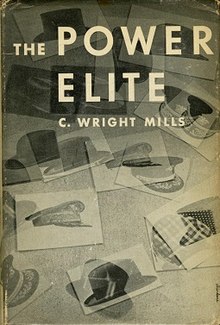The Power Elite
 First edition, 1956 | |
| Author | C. Wright Mills |
|---|---|
| Country | United States |
| Language | English |
| Subject | Sociology |
| Publisher | Oxford University Press |
Publication date | April 19, 1956[1] |
The Power Elite is a 1956 book by
Background
The book is something of a counterpart of Mills' 1951 work,
Summary

According to Mills, the eponymous "power elite" are those that occupy the dominant positions, in the three pillar institutions (state security, economic and political) of a dominant country. Their decisions (or lack thereof) have enormous consequences, not only for Americans but, "the underlying populations of the world." Mills posits that the institutions that they head are a triumvirate of groups that have inherited or succeeded weaker predecessors:
- "two or three hundred giant corporations" which have replaced the traditional agrarian and craft economy,
- a strong federal political order that has inherited power from "a decentralized set of several dozen states" and "now enters into each and every cranny of the social structure," and
- the military establishment, formerly an object of "distrust fed by state militia," but now an entity with "all the grim and clumsy efficiency of a sprawling bureaucratic domain."
Importantly and as distinct from modern American
Mills identifies two classes of

The resulting elites, who control the three dominant institutions (military, economy and political system) can be generally grouped into one of six types, according to Mills:
- the "Metropolitan 400:" members of historically-notable local families in the principal American cities who are generally represented on the Social Register
- "Celebrities:" prominent entertainers and media personalities
- the "Chief Executives:" presidents and CEOs of the most important companies within each industrial sector
- the "Corporate Rich:" major landowners and corporate shareholders
- the "Warlords:" senior military officers, most importantly the Joint Chiefs of Staff
- the "Political Directorate:" "fifty-odd men of the executive branch" of the U.S. federal government, including the senior leadership in the bureaucrats
Mills formulated a very short summary of his book: "Who, after all, runs America? No one runs it altogether, but in so far as any group does, the power elite."[3]
Reception and criticism
Commenting on The Power Elite,
In popular culture
In 2017, episode 5 of the
In the Noah Baumbach film While We're Young, the protagonist Josh Schrebnick is a documentarian who cites Mills, and frequently cites the expertise of the subject of his documentary, Ira Mandelstam's views as they relate to The Power Elite.
See also
- Elite theory
- Friendly Fascism, 1980 book
- Iron law of oligarchy
- Mass society
- Military-industrial complex
- New Left
- Power (social and political)
- Social alienation
References
- ^ "Books—Authors". The New York Times: 31. April 11, 1956.
- ^ C.Wright Mills: Power, Politics and People, (New York, 1963), p. 174.
- ^ Mills, C. Wright. The Sociological Imagination. Oxford University Press. p. 31.
- ^ a b c Summers, John (14 May 2006). "The Deciders". New York Times. Retrieved 14 February 2014.
- ^ Wrong, Dennis (September 1956). "The Power Elite, by C. Wright Mills". Commentary Magazine. Retrieved 14 February 2014.
- ^ Woodard, Calvin (December 1956). "THE POWER ELITE, by C. Wright Mills". Louisiana Law Review. Retrieved 14 February 2014.
- ^ Domhoff, G. William (2006). "Mills's The Power Elite, 50 Years Later". Contemporary Sociology.
Further reading
- Crockett, Norman L. ed. The power elite in America (1970), escerpts from experts online free
External links
- C.W Mills, Structure of Power in American Society, British Journal of Socoiology, Vol.9.No.1 1958
- C. Wright Mills, About F. Neumanns study Structure of Nazi Germany in Power, Politics and People
- A Mills Revival? by S .Aronowitz
- C.Wright Mills, On Intellectual Craftsmanship from The Sociological Imagination, How Power Elite was made
- Sociology-Congress in Köln 2000 workshop: C. Wright Mills and his Power Elite: Actuality today?
- Art inspired by The Power Elite
